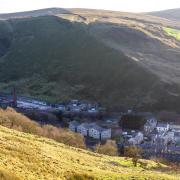What is in the plates is as interesting as the food served on them at an award winning Lancashire restaurant and hotel. Sue Riley reports.

It’s not just the food that creates an impression at a restaurant. Everything from the welcome, the wallpaper and even down to the slates on the floor, it all creates a picture of the dining experience you can expect.
The owners of Hipping Hall, a multi award winning establishment in Cowan Bridge near Kirkby Lonsdale, take attention to detail that step further. They commissioned Martin Miles Moore and Siobhan Newton to create an entirely new range of crockery and table decorations just for them. They’re made using minerals and sands found in Lancashire, Cumbria and Yorkshire. So far the hotel and restaurant, on the border of the three counties, has commissioned 649 individual pieces. And that number is still rising.
As you’d expect from a high class restaurant – a Lancashire Life Food & Drink award winner – the food is all about provenance. But head chef Oli Martin wanted to take it one step further and get a range of crockery made from local things too.
‘Our style of food is similar to Martin’s philosophy – complex simplicity,’ explained Oli. ‘The bowls may look simple but they are not at all. We change the menu quite often though, sometimes things are just on the menu for a couple of days, so we needed something neutral as we do not design a plate per dish.’ .

So the talented chef and husband and wife team Martin and Siobhan worked together on the pieces to create beautiful bespoke crockery which not only represent Hipping but the three counties as well.
‘It’s been a proper collaboration - Martin and Oli were working together as two artists, which they both are,’ said Siobhan.
Martin - who used to sell his work internationally but ‘retired’ in the 1990s to continue his first career of physiotherapy – used sand from the Rivers Wenning and Lune in his glazes to give a speckled effect to the plates and dishes. Very fitting as the word Hipping refers to the steps crossing a small beck on the land which feeds into both rivers. His plates and bowls look like stone and capture the texture and colours of the surrounding area.
‘Something we are now thinking about is grinding the pebbles from the beck into dust and incorporating them,’ said Martin. ‘Certainly one of the things which is really important is that you make work which is robust and the food looks beautiful on them. I am making canvasses for Oli to put his art on.’

As part of the making process he made 30 different sample glazes and tester plates were kept in Hipping Hall’s dishwashers for days on end. The team eventually settled on the cream coloured speckled glaze using sand from the rivers, slate from Coniston and others using powdered Shap granite. This made a beautiful pink glaze and inspired Oli to create a new rhubarb dish.
Martin has plans to take the link between food and plate one step further. Oli has been saving waste from pumpkins and drying them before Martin turns them into a useable ash that he will put into a glaze. Such is the alchemy of biscuit firing, he has no idea how the ash will colour the plates until he removes them from the kiln.
The theme of fire and smoke runs through Siobhan’s work – Hipping Hall started off life as a blacksmiths and Siobhan was the first woman retained firefighter in Lancashire in her youth. Her small golden globes inlaid with four layers of copper leaf sit on each table in Hipping’s newly refurbished restaurant with a much larger one in the fireplace echoing the colours of fire and flames. Her pots are made using copper and haematite iron foraged from the Florence mine in Egremont.
‘This was a blacksmiths forge and we wanted to capture as much of that as we could; all the ceramics bring elements of that story and the three counties,’ said Siobhan.
A true collaborative process, Martin and Siobhan brought a pottery wheel and kiln to Hipping Hall for the staff to make and decorate their own pieces – not for use in the restaurant. They now plan to hold pottery workshops there alongside ones they hold at their Miles-Moore Ceramics studio in nearby Lupton.
As part of the refurbishment of the hotel, the owners at Hipping Hall also bought tweeds from Clitheroe-based Benjamin Thornber & Sons and commissioned Wallace Seymour in Horton in Ribblesdale to create a range of bespoke pigments to use on the walls including Backbarrow Blue from the Lake District.
Andrew Wildsmith, owner of Hipping Hall, said: ‘Each of our hotels are very different, they are distinct, the surroundings they sit in are different, the buildings are different. In my view this needs to be recognised, you can’t just use a one size fits all approach.
‘With each hotel we have set out on a very considered journey. There is a connection between each and its surroundings, not just in the food, but in the very heart of each of them.
‘We have used local artisan craftspeople to create paints, fabrics, metalwork, ceramics and artwork to reflect the individuality of each property and the surroundings they sit.
‘We have deliberately set out to connect with the landscape around us in every way possible, to create a sense of place that our guests can understand and appreciate. For us it is important that we use local food producers and craftspeople, in doing so we are in a small way helping to sustain our local communities. After all, we are part of these communities and we need them to be vibrant for our future too.’



























